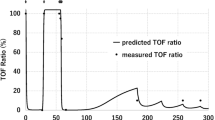Abstract
Overdosage of muscle relaxant has been given as a possible explanation for the hypotensive episodes occurring during the management of tetanus. The aim of the present work was to study the pharmacokinetics of pancuronium during long term infusion. Pancuronium was administered to eight patients with severe tetanus for a period varying from 8 to 24 days. The concentration of pancuronium was measured daily in plasma and urine using a fluorimetric method. The plasma concentration varied from 0.27 to 0.48 μg/ml. No tendency to accumulation was observed. The plasma concentration fell rapidly below the level associated with muscle relaxation when pancuronium was discontinued. This absence of accumulation can be explained by a rapid elimination of pancuronium through the kidney according to a process of ultrafiltration.
Similar content being viewed by others
References
Adams, E.B., Holloway, R., Thambiran, A.K., Desai, S.D.: Usefulness of intermittent positive-pressure respiration in the treatment of tetanus. Lancet2, 1176 (1966)
Agoston, S., Vermeer, G.A., Kersten, U.W., Meijer, D.K.F.: The fate of pancuronium bromide in man. Acta. Anaesth. Scand.17, 267 (1973)
Agoston, S., Crul, J.F., Kersten, U.W., Scaf, A.H.J.: Relationship of the serum concentration of pancuronium to its neuromuscular activity in man. Anesthesiology47, 509 (1977)
Baudraz, P., Perret, C., Tatti, V., et al.: Trente cas de tétanus traités par trachéotomie et curarisation prolongée. Helv. Med. Acta1, 149 (1961)
Clifton, B.: Hypotension associated with tetanus. Lancet2, 785 (1964)
Duvaldestin, P., Henzel, D., Demetriou, M., Desmonts, J.M.: The placental transfer of pancuronium and its pharmacokinetics during caesarean section. Acta Aneasth. Scand.22, 327 (1978)
Kersten, U.W., Meijer, D.K.F., Agoston, S.: Fluorimetric and chromatographic determination of pancuronium bromide and its metabolites in biological materials. Clin. Chim. Acta44, 59 (1973)
Mollaret, P., Bastin, R., Goulon, M., et al.: Le traitement du tétanos au centre de réanimation neurorespiratoire de l'hôpital Claude-Bernard (Enseignements tirés de 210 observations). Presse Med.7, 217 (1960)
Rowe, J.W.: Clinical research on aging: strategies and directions, New Engl. J. Med.297, 1332 (1977)
Somogyi, A.A., Shanks, C.A., Triggs, E.J.: Clinical pharmacokinetics of pancuronium bromide. Eur. J. Clin. Pharmacol.10, 367 (1976)
Stoelting, R.K.: The hemodynamic effects of pancuronium and d-tubocurarine in anesthetized patients. Anesthesiology36, 612 (1972)
Tsueda, K., Olivier, P.B., Richter, R.W.: Cardiovascular manifestations of tetanus. Anesthesiology40, 588 (1974)
Vic-Dupont, V., Vachon, F., Gibert, C., et al.: Conduite du traitement symptomatique dans le tétanus aigü généralisé de l'adulte. L'année en Réanimation Médicale 1975–1976. Vic-Dupont, V.. Paris: Flammarion (ed.) p. 171. 1976
Waser, P.: Localization of14C-pancuronium by histo-and wholebody-autoradiography in normal and pregnant mice. Naunyn Schmiedeberg's Arch. Pharmacol.279, 399 (1973)
Waud, B.E., Waud, D.R.: The margin of safety of neuromuscular transmission in the muscle of the diaphragm. Anesthesiology37, 417 (1972)
Author information
Authors and Affiliations
Additional information
This work was supported by grants from Faculté de Médecine Xavier-Bichat (Université Paris VII). This work was presented in part at the Second World Congress on Intensive Care, September 1977, Paris, France
Rights and permissions
About this article
Cite this article
Duvaldestin, P., Gibert, C., Henzel, D. et al. Pancuronium blood level monitoring in patients with tetanus. Intensive Care Med 5, 111–114 (1979). https://doi.org/10.1007/BF01683191
Issue Date:
DOI: https://doi.org/10.1007/BF01683191




